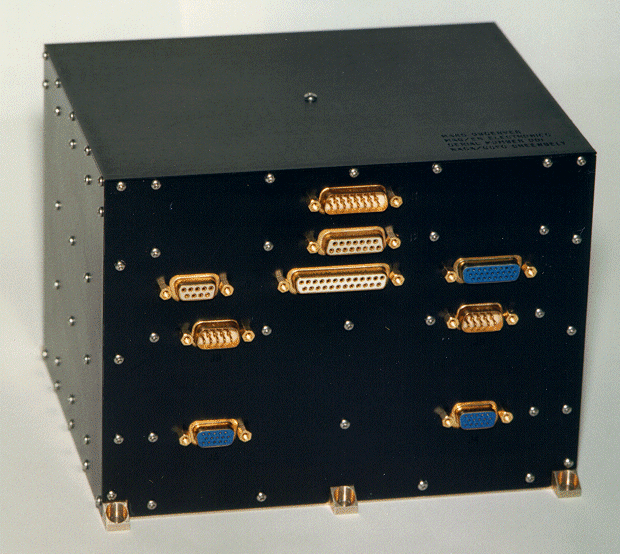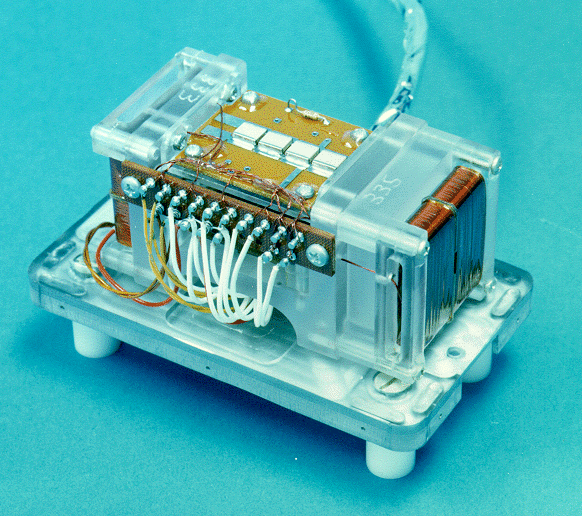 Dual Processing Unit |
 Dual Fluxgate Magnetometer Sensor |
|
The basic instrumentation selected for the WIND Magnetic Field Investigation (MFI) is based on the magnetometers previously developed for the Voyager, ISPM, GIOTTO, and Mars Observer missions which represent state-of-the-art instruments with unparalleled performance. Table I summarizes the principal instrument characteristics. The basic configuration consists of dual, wide range (±0.001 to ±65536 nT) triaxial fluxgate magnetometers mounted remote from the spacecraft body on a deployable boom, a 12-bit resolution A/D converter system and a microprocessor controlled data processing and control unit (DPU). The outer magnetometer sensor is mounted at the end of the boom while the inner unit is located approximately midway between the outer one and the main body of the spacecraft. This configuration allows the real-time estimation and elimination of the dipolar components of the spacecraft-generated magnetic field in order to obtain a more accurate ambient field. A block diagram of the MFI instrumentation is shown in Figure 1. The advantages of the dual magnetometer approach for weak magnetic field measurements like those associated with the IMF, have been proven over many space missions since their original introduction by Ness et al. (1971). The 12 m long deployable boom is of the 'astromast' type and places the sensors at two different radial distances from the center of the spacecraft while the signal processing electronics package is mounted on the main spacecraft body. The dual magnetometer system is supported by the fully redundant DPU which interfaces with the spacecraft data and power systems. The use of full redundancy in the MFI instrument is an important feature that emphasizes the critical nature of the magnetic field measurements for the achievement of the WIND and ISTP science objectives. It significantly reduces the probability of failures and takes advantage of the inherent redundancy provided by the dual magnetometer configuration. This redundancy includes assigning by ground command either primary or secondary data stream for the outer sensor and likewise for the inner sensor. In addition to the block redundancy provided, each magnetometer system incorporates self-resetting electronic 'fuses' which isolate the common subsystems in case of catastrophic problems. Each sensor assembly consists of an orthogonal triaxial arrangement of ringcore fluxgate sensors plus additional elements required for thermal control. The fluxgate sensors are the latest in a series developed for weak magnetic field measurements by Acuña (1974) and which have been extensively used in missions like VOYAGER, AMPTE, GIOTTO, Mars Observer, CLUSTER, etc. due to their superior performance and low power consumption. The detailed principles of operation of fluxgate magnetometers are well known and will not be repeated here. It is sufficient to refer to Figure 2 for a simplified description of their operation. (For additional information the reader is referred to Ness, 1970; Acuña, 1974; and Acuña and Ness, 1976a, b.) As shown in the figure the fluxgate sensors are driven cyclically to saturation by a 15 KHz signal derived from the DPU master clock. The sensor drive signals are derived from an efficient high energy storage system which is capable of driving the ring core sensors to peak excitations which are more than 100 times the coercive saturation force of the cores. This type of excitation eliminates from consideration many 'perming' problems which have been attributed to fluxgate sensors in the past. In the absence of an external magnetic field, the fluxgate sensors are 'balanced' and no signal appears at the output terminals. When an external field is applied, the sensor balance is disturbed and a signal containing only even harmonics of the drive frequency appears at the output of the sensors. After amplification and filtering, this signal is applied to a synchronous detector and high gain integrating amplifier which is used to generate a current proportional to the magnitude of the applied field which is fed-back to the sensor to null the effective magnetic field seen by it. The output of a single axis magnetometer is then a voltage proportional to the magnitude, direction and polarity of the ambient magnetic field with respect to the sensor axis orientation. A triaxial magnetometer is thus created when three single axis sensors are arranged in an orthogonal configuration and three sets of signal processing electronics are used to produce three output voltages proportional to the orthogonal components of the ambient magnetic field. The noise performance of the MFI fluxgate sensors is shown in Figures 3(a) and 3(b). Total r.m.s. noise level over the 0-10 Hz band does not exceed 0.006 nT. This noise level is several orders of magnitude below the lowest recorded levels of IMF fluctuations at 1 AU and is more than adequate to properly detect and identify all magnetic field phenomena of interest to MFI. The six analog signals generated by the Outboard (OB) and Inboard (IB) magnetometers are digitized by the 12-bit successive approximation A/D converter. The 12-bit resolution allows the recovery of a very large dynamic range of signals spanning 72 dB. To further increase the measurement dynamic range and to accommodate simplified integration and test requirements during spacecraft testing, the dynamic range of the magnetometers can be changed automatically if the magnitude of the measured signals exceeds or drops below established digital thresholds illustrated in Figure 4. In this fashion, the MFI instrumentation can cover eight orders of magnitude in magnetic field measurement capability, from 0.001 to 65,536 nT per axis. The operation of the automatic ranging system is controlled by the microprocessor and allowed only at clearly defined times in the telemetry frame to avoid ambiguities in the interpretation of the data. When the digitized output of any magnetometer axis exceeds 7/8's of full scale, the microprocessor generates a command to step up (increase) the magnetometer to the next, less sensitive, range. Conversely, when the output of all axes drops below 1/8-th of full scale, the DPU commands the appropriate magnetometer to step down (decrease) to the next most sensitive range. A 'guard band' of 1/8-th scale is provided to avoid the loss of measurements due to saturation until the range is updated. The decision to increase or decrease dynamic range is made at the basic internal sampling rate of 44 vectors/s. (At this same rate, the Outboard sensor magnetic field data is distributed to the rest of the WIND instruments.) However, the MFI telemetry allocation is not sufficient to allow the transmission of all the data to the ground, so on-board data averaging, compression, and decimation must be used to reduce the 'raw' rate to an acceptable value. The DPU also controls calibration sequences which provide the necessary currents to determine the scale factor of each of the Outboard and Inboard magnetometer axes for various dynamic ranges as well as the determination of zero offsets associated with the electronics by implementing a 180° phase reversal of the signals processed (electronic 'flipping'). |
 Dual Processing Unit |
 Dual Fluxgate Magnetometer Sensor |